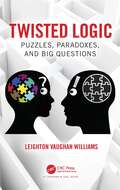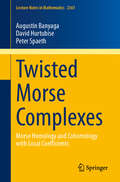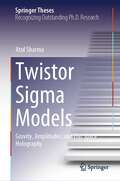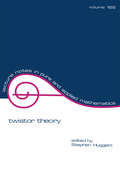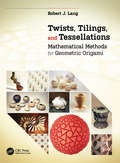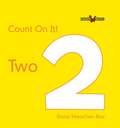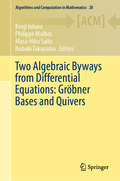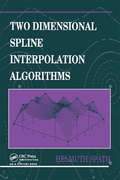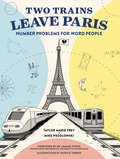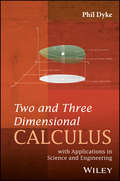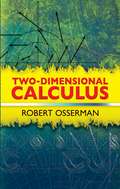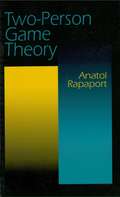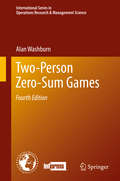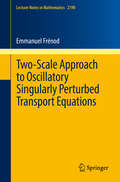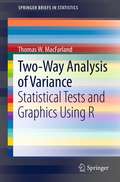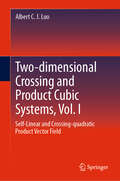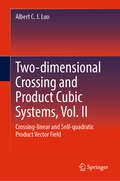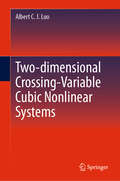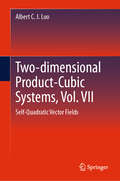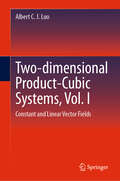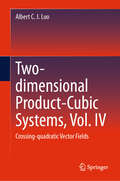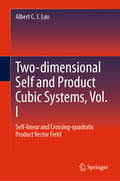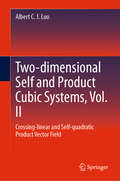- Table View
- List View
Twisted Logic: Puzzles, Paradoxes, and Big Questions
by Leighton Vaughan WilliamsTwisted Logic: Puzzles, Paradoxes, and Big Questions delves into the intriguing world of twisted logic, where everyday conundrums, bewildering paradoxes, and life's big questions are investigated and decoded. Crafted for the curious mind, this book sheds light on how our intuition and common sense can often mislead us. Without the need for technical jargon or mathematical prowess, it serves as your personal compass through fascinating intellectual landscapes and ultimate explorations. From the quirky corners of Bayesian reasoning to practical strategies in daily choices, this is your companion for a clearer way of thinking.Features: A comprehensive toolkit to refine your cognitive processes and avoid common pitfalls. Insights into the oddities of probability, strategy, and fate that govern our lives. A fresh perspective on everyday decisions and life's larger dilemmas, including finding everything from a place to eat to a new home to a life partner. Practical advice on optimising daily routines, such as determining the best time of day to arrange important appointments. Thought-provoking 'When Should We?' questions that challenge us to think critically about decision-making in our lives. Prepare to challenge your perceptions and unveil hidden truths. Twisted Logic is an enlightening adventure that promises to transform the mundane into the extraordinary. Embark on a journey where the only thing certain is the thrill of the unknown.
Twisted Morse Complexes: Morse Homology and Cohomology with Local Coefficients (Lecture Notes in Mathematics #2361)
by Augustin Banyaga David Hurtubise Peter SpaethThis book gives a detailed presentation of twisted Morse homology and cohomology on closed finite-dimensional smooth manifolds. It contains a complete proof of the Twisted Morse Homology Theorem, which says that on a closed finite-dimensional smooth manifold the homology of the Morse–Smale–Witten chain complex with coefficients in a bundle of abelian groups G is isomorphic to the singular homology of the manifold with coefficients in G. It also includes proofs of twisted Morse-theoretic versions of well-known theorems such as Eilenberg's Theorem, the Poincaré Lemma, and the de Rham Theorem. The effectiveness of twisted Morse complexes is demonstrated by computing the Lichnerowicz cohomology of surfaces, giving obstructions to spaces being associative H-spaces, and computing Novikov numbers. Suitable for a graduate level course, the book may also be used as a reference for graduate students and working mathematicians or physicists.
Twistor Sigma Models: Gravity, Amplitudes, and Flat Space Holography (Springer Theses)
by Atul SharmaIn recent decades, twistor theory has grown into an irreplaceable tool for the study of scattering amplitudes in gauge theory and gravity. This book introduces the reader to cutting-edge advances in twistor theory and its applications to general relativity. The problem of graviton scattering in four dimensions is shown to be dual to dramatically simpler computations in a two-dimensional CFT known as a twistor sigma model. Twistor sigma models are the first step toward a holographic description of gravity in asymptotically flat space-times. They underpin the infinitely many asymptotic symmetries of flat space physics discovered in celestial holography, and extend them to exciting new arenas like curved space-times. They also yield intrinsically mathematical results in the field of hyperkähler manifolds. This volume will be of broad interest to students and researchers looking for an accessible entry point into twistor geometry, scattering amplitudes, and celestial holography. It will also provide an invaluable reference for specialists by bringing together results from a host of different disciplines.
Twistor Theory
by AuthorPresents the proceedings of the recently held conference at the University of Plymouth. Papers describe recent work by leading researchers in twistor theory and cover a wide range of subjects, including conformal invariants, integral transforms, Einstein equations, anti-self-dual Riemannian 4-manifolds, deformation theory, 4-dimensional conformal structures, and more.;The book is intended for complex geometers and analysts, theoretical physicists, and graduate students in complex analysis, complex differential geometry, and mathematical physics.
Twists, Tilings, and Tessellations: Mathematical Methods for Geometric Origami (AK Peters/CRC Recreational Mathematics Series)
by Robert J. LangTwists, Tilings, and Tessellation describes the underlying principles and mathematics of the broad and exciting field of abstract and mathematical origami, most notably the field of origami tessellations. It contains folding instructions, underlying principles, mathematical concepts, and many beautiful photos of the latest work in this fast-expanding field.
Two (Bookworms Count on It!)
by Dana Meachen RauPublisher's summary: Identifies things that inherently come in twos and lists other examples. The simple and engaging text and photos of Count On It! accomplish two things at once: They teach children how to count as well as to read. The direct correspondence between image and text and consistent format make these books ideal for the beginning reader and mathematician.
Two Algebraic Byways from Differential Equations: Gröbner Bases and Quivers (Algorithms and Computation in Mathematics #28)
by Kenji Iohara Philippe Malbos Masa-Hiko Saito Nobuki TakayamaThis edited volume presents a fascinating collection of lecture notes focusing on differential equations from two viewpoints: formal calculus (through the theory of Gröbner bases) and geometry (via quiver theory). Gröbner bases serve as effective models for computation in algebras of various types. Although the theory of Gröbner bases was developed in the second half of the 20th century, many works on computational methods in algebra were published well before the introduction of the modern algebraic language. Since then, new algorithms have been developed and the theory itself has greatly expanded. In comparison, diagrammatic methods in representation theory are relatively new, with the quiver varieties only being introduced – with big impact – in the 1990s. Divided into two parts, the book first discusses the theory of Gröbner bases in their commutative and noncommutative contexts, with a focus on algorithmic aspects and applications of Gröbner bases to analysis on systems of partial differential equations, effective analysis on rings of differential operators, and homological algebra. It then introduces representations of quivers, quiver varieties and their applications to the moduli spaces of meromorphic connections on the complex projective line. While no particular reader background is assumed, the book is intended for graduate students in mathematics, engineering and related fields, as well as researchers and scholars.
Two Dimensional Spline Interpolation Algorithms
by Helmuth SpäthThese volumes present a practical introduction to computing spline functions, the fundamental tools for fitting curves and surfaces in computer-aided deisgn (CAD) and computer graphics.
Two Eyes, Two Ears (Into Reading, Level D #78)
by Annette Smith Lindsay EdwardsNIMAC-sourced textbook
Two Trains Leave Paris: Number Problems for Word People
by Taylor Frey Mike WesolowskiEntertaining word problems that let verbal types master the language of math!Math is a universal language, but it’s also the least understood and most undervalued subject taught in school. Two Trains Leave Paris: Number Problems for Word People offers an opportunity to experience math like never before. You must use the Pythagorean Theorem to figure out how far apart two ex-lovers are when they simultaneously realize that they cannot live without each other. You must use addition (and logic) to explore the ridiculous (and patriarchal!) wage gap. Throughout six math-themed chapters, readers will follow a series of characters as they apply for jobs, fall in love, get abducted by aliens, and experience many of life’s other big and small moments, all of which are dictated by—you guessed it—math! With the help of humor, mathematical history, and how-to-solve sections, Two Trains Leave Paris asks readers to help its characters find growth in the most unexpected of places: word problems. And the answers are, of course, in the back.
Two and Three Dimensional Calculus: with Applications in Science and Engineering
by Phil DykeCovers multivariable calculus, starting from the basics and leading up to the three theorems of Green, Gauss, and Stokes, but always with an eye on practical applications. Written for a wide spectrum of undergraduate students by an experienced author, this book provides a very practical approach to advanced calculus—starting from the basics and leading up to the theorems of Green, Gauss, and Stokes. It explains, clearly and concisely, partial differentiation, multiple integration, vectors and vector calculus, and provides end-of-chapter exercises along with their solutions to aid the readers’ understanding. Written in an approachable style and filled with numerous illustrative examples throughout, Two and Three Dimensional Calculus: with Applications in Science and Engineering assumes no prior knowledge of partial differentiation or vectors and explains difficult concepts with easy to follow examples. Rather than concentrating on mathematical structures, the book describes the development of techniques through their use in science and engineering so that students acquire skills that enable them to be used in a wide variety of practical situations. It also has enough rigor to enable those who wish to investigate the more mathematical generalizations found in most mathematics degrees to do so. Assumes no prior knowledge of partial differentiation, multiple integration or vectors Includes easy-to-follow examples throughout to help explain difficult concepts Features end-of-chapter exercises with solutions to exercises in the book. Two and Three Dimensional Calculus: with Applications in Science and Engineering is an ideal textbook for undergraduate students of engineering and applied sciences as well as those needing to use these methods for real problems in industry and commerce.
Two-Dimensional Calculus
by Robert OssermanThe basic component of several-variable calculus, two-dimensional calculus is vital to mastery of the broader field. This extensive treatment of the subject offers the advantage of a thorough integration of linear algebra and materials, which aids readers in the development of geometric intuition. An introductory chapter presents background information on vectors in the plane, plane curves, and functions of two variables. Subsequent chapters address differentiation, transformations, and integration. Each chapter concludes with problem sets, and answers to selected exercises appear at the end of the book.
Two-Person Game Theory
by Anatol Rapoport"Game theory is an intellectual X-ray. It reveals the skeletal structure of those systems where decisions interact, and it reveals, therefore, the essential structure of both conflict and cooperation." -- Kenneth BouldingThis fascinating and provocative book presents the fundamentals of two-person game theory, a mathematical approach to understanding human behavior and decision-making, Developed from analysis of games of strategy such as chess, checkers, and Go, game theory has dramatic applications to the entire realm of human events, from politics, economics, and war, to environmental issues, business, social relationships, and even "the game of love." Typically, game theory deals with decisions in conflict situations.Written by a noted expert in the field, this clear, non-technical volume introduces the theory of games in a way which brings the essentials into focus and keeps them there. In addition to lucid discussions of such standard topics as utilities, strategy, the game tree, and the game matrix, dominating strategy and minimax, negotiated and nonnegotiable games, and solving the two-person zero-sum game, the author includes a discussion of gaming theory, an important link between abstract game theory and an experimentally oriented behavioral science. Specific applications to social science have not been stressed, but the methodological relations between game theory, decision theory, and social science are emphasized throughout.Although game theory employs a mathematical approach to conflict resolution, the present volume avoids all but the minimum of mathematical notation. Moreover, the reader will find only the mathematics of high school algebra and of very elementary analytic geometry, except for an occasional derivative. The result is an accessible, easy-to-follow treatment that will be welcomed by mathematicians and non-mathematicians alike.
Two-Person Zero-Sum Games
by Alan WashburnTwo-person zero-sum game theory deals with situations that are perfectly competitive--there are exactly two decision makers for whom there is no possibility of cooperation or compromise. It is the most fundamental part of game theory, and the part most commonly applied. There are diverse applications to military battles, sports, parlor games, economics and politics. The theory was born in World War II, and has by now matured into a significant and tractable body of knowledge about competitive decision making. The advent of modern, powerful computers has enabled the solution of many games that were once beyond computational reach. Two-Person Zero-Sum Games, 4th Ed. offers an up-to-date introduction to the subject, especially its computational aspects. Any finite game can be solved by the brute force method of enumerating all possible strategies and then applying linear programming. The trouble is that many interesting games have far too many strategies to enumerate, even with the aid of computers. After introducing ideas, terminology, and the brute force method in the initial chapters, the rest of the book is devoted to classes of games that can be solved without enumerating every strategy. Numerous examples are given, as well as an extensive set of exercises. Many of the exercises are keyed to sheets of an included Excel workbook that can be freely downloaded from the SpringerExtras website. This new edition can be used as either a reference book or as a textbook.
Two-Scale Approach to Oscillatory Singularly Perturbed Transport Equations (Lecture Notes in Mathematics #2190)
by Emmanuel FrénodThis book presents the classical results of the two-scale convergence theory and explains – using several figures – why it works. It then shows how to use this theory to homogenize ordinary differential equations with oscillating coefficients as well as oscillatory singularly perturbed ordinary differential equations. In addition, it explores the homogenization of hyperbolic partial differential equations with oscillating coefficients and linear oscillatory singularly perturbed hyperbolic partial differential equations. Further, it introduces readers to the two-scale numerical methods that can be built from the previous approaches to solve oscillatory singularly perturbed transport equations (ODE and hyperbolic PDE) and demonstrates how they can be used efficiently. This book appeals to master’s and PhD students interested in homogenization and numerics, as well as to the Iter community.
Two-Tier Stochastic Frontier Analysis for the Social Sciences
by Christopher F. Parmeter Alecos PapadopoulosThis textbook provides an up-to-date treatment of the two-tier stochastic frontier model and its applications across the social sciences. It is a cohesive treatise on both the classical methods of estimation and inference and various machinations of the two-tier stochastic frontier model, as well as more recently developed tools that can shed new insight into why these opposing latent forces which affect economic, sociopolitical, and even psychological outcomes, exist, and to what extent. The text is intended to be a self-contained reference for practitioners to rely on when using these methods in their research, regardless of field. It includes sixteen empirical applications on diverse topics (labor market, housing market, consumer goods, production economics, sociology, international relations, psychology, public education, healthcare management, environmental policy). The book is accompanied by a dedicated website where 2TSF software code in the R and gretl open-source platforms is provided.
Two-Way Analysis of Variance
by Thomas W. MacfarlandIn statistics, analysis of variance (ANOVA) is a collection of statistical models used to distinguish between an observed variance in a particular variable and its component parts. In its simplest form, ANOVA provides a statistical test of whether or not the means of several groups are all equal, and therefore generalizes a test between these groups. One test often used by statisticians and researchers in their work is the Two-Way ANOVA, which determines the differences--and possible interactions--when variables are presented from the perspective of two or more categories. When a Two-Way ANOVA is implemented, it enables one to compare and contrast variables resulting from independent or joint actions. This brief provides guidance on how R can be used to facilitate Two-Way ANOVA for data analysis and graphical presentation. Along with instruction on the use of R and R syntax associated with Two-Way ANOVA, this brief will also reinforce the use of descriptive statistics and graphical figures to complement outcomes from parametric Two-Way ANOVA.
Two-dimensional Crossing and Product Cubic Systems, Vol. I: Self-linear and Crossing-quadratic Product Vector Field
by Albert C. LuoThis book, the 14th of 15 related monographs on Cubic Dynamical Systems, discusses crossing and product cubic systems with a self-linear and crossing-quadratic product vector field. Dr. Luo discusses singular equilibrium series with inflection-source (sink) flows that are switched with parabola-source (sink) infinite-equilibriums. He further describes networks of simple equilibriums with connected hyperbolic flows are obtained, which are switched with inflection-source (sink) and parabola-saddle infinite-equilibriums, and nonlinear dynamics and singularity for such crossing and product cubic systems. In such cubic systems, the appearing bifurcations are: - double-inflection saddles, - inflection-source (sink) flows, - parabola-saddles (saddle-center), - third-order parabola-saddles, - third-order saddles and centers.
Two-dimensional Crossing and Product Cubic Systems, Vol. II: Crossing-linear and Self-quadratic Product Vector Field
by Albert C. LuoThis book, the 15th of 15 related monographs on Cubic Dynamic Systems, discusses crossing and product cubic systems with a crossing-linear and self-quadratic product vector field. The author discusses series of singular equilibriums and hyperbolic-to-hyperbolic-scant flows that are switched through the hyperbolic upper-to-lower saddles and parabola-saddles and circular and hyperbolic upper-to-lower saddles infinite-equilibriums. Series of simple equilibrium and paralleled hyperbolic flows are also discussed, which are switched through inflection-source (sink) and parabola-saddle infinite-equilibriums. Nonlinear dynamics and singularity for such crossing and product cubic systems are presented. In such cubic systems, the appearing bifurcations are: parabola-saddles, hyperbolic-to-hyperbolic-secant flows, third-order saddles (centers) and parabola-saddles (saddle-center).
Two-dimensional Crossing-Variable Cubic Nonlinear Systems
by Albert C. LuoThis book is the fourth of 15 related monographs presents systematically a theory of crossing-cubic nonlinear systems. In this treatment, at least one vector field is crossing-cubic, and the other vector field can be constant, crossing-linear, crossing-quadratic, and crossing-cubic. For constant vector fields, the dynamical systems possess 1-dimensional flows, such as parabola and inflection flows plus third-order parabola flows. For crossing-linear and crossing-cubic systems, the dynamical systems possess saddle and center equilibriums, parabola-saddles, third-order centers and saddles (i.e, (3rd UP+:UP+)-saddle and (3rdUP-:UP-)-saddle) and third-order centers (i.e., (3rd DP+:DP-)-center, (3rd DP-, DP+)-center) . For crossing-quadratic and crossing-cubic systems, in addition to the first and third-order saddles and centers plus parabola-saddles, there are (3:2)parabola-saddle and double-inflection saddles, and for the two crossing-cubic systems, (3:3)-saddles and centers exist. Finally,the homoclinic orbits with centers can be formed, and the corresponding homoclinic networks of centers and saddles exist. Readers will learn new concepts, theory, phenomena, and analytic techniques, including · Constant and crossing-cubic systems · Crossing-linear and crossing-cubic systems · Crossing-quadratic and crossing-cubic systems · Crossing-cubic and crossing-cubic systems · Appearing and switching bifurcations · Third-order centers and saddles · Parabola-saddles and inflection-saddles · Homoclinic-orbit network with centers · Appearing bifurcations
Two-dimensional Product Cubic Systems, Vol. VII: Self- Quadratic Vector Fields
by Albert C. LuoThis book is the seventh of 15 related monographs, concerns nonlinear dynamics and singularity of cubic dynamical systems possessing a product-cubic vector field and a self-univariate quadratic vector field. The equilibrium singularity and bifurcation dynamics are discussed. The saddle-source (sink) is the appearing bifurcations for saddle and source (sink). The double-saddle equilibriums are the appearing bifurcations of the saddle-source and saddle-sink, and also the appearing bifurcations of the network of saddles, sink and source. The infinite-equilibriums for the switching bifurcations include: • inflection-saddle infinite-equilibriums, • hyperbolic-source (sink) infinite-equilibriums, • up-down (down-up) saddle infinite-equilibriums, • inflection-source (sink) infinite-equilibriums.
Two-dimensional Product-Cubic Systems, Vol. I: Constant and Linear Vector Fields
by Albert C. LuoThis book, the fifth of 15 related monographs, presents systematically a theory of product-cubic nonlinear systems with constant and single-variable linear vector fields. The product-cubic vector field is a product of linear and quadratic different univariate functions. The hyperbolic and hyperbolic-secant flows with directrix flows in the cubic product system with a constant vector field are discussed first, and the cubic product systems with self-linear and crossing-linear vector fields are discussed. The inflection-source (sink) infinite equilibriums are presented for the switching bifurcations of a connected hyperbolic flow and saddle with hyperbolic-secant flow and source (sink) for the connected the separated hyperbolic and hyperbolic-secant flows. The inflection-sink and source infinite-equilibriums with parabola-saddles are presented for the switching bifurcations of a separated hyperbolic flow and saddle with a hyperbolic-secant flow and center. Readers learn new concepts, theory, phenomena, and analysis techniques, such as Constant and product-cubic systems, Linear-univariate and product-cubic systems, Hyperbolic and hyperbolic-secant flows, Connected hyperbolic and hyperbolic-secant flows, Separated hyperbolic and hyperbolic-secant flows, Inflection-source (sink) Infinite-equilibriums and Infinite-equilibrium switching bifurcations.
Two-dimensional Product-Cubic Systems, Vol. IV: Crossing-quadratic Vector Fields
by Albert C. LuoThis book, the eighth of 15 related monographs, discusses a product-cubic dynamical system possessing a product-cubic vector field and a crossing-univariate quadratic vector field. It presents equilibrium singularity and bifurcation dynamics, and . the saddle-source (sink) examined is the appearing bifurcations for saddle and source (sink). The double-inflection saddle equilibriums are the appearing bifurcations of the saddle and center, and also the appearing bifurcations of the network of saddles and centers. The infinite-equilibriums for the switching bifurcations featured in this volume include: Parabola-source (sink) infinite-equilibriums, Inflection-source (sink) infinite-equilibriums, Hyperbolic (circular) sink-to source infinite-equilibriums, Hyperbolic (circular) lower-to-upper saddle infinite-equilibriums.
Two-dimensional Self and Product Cubic Systems, Vol. I: Self-linear and Crossing-quadratic Product Vector Field
by Albert C. LuoThis book, the 14th of 15 related monographs on Cubic Dynamical Systems, discusses crossing and product cubic systems with a self-linear and crossing-quadratic product vector field. Dr. Luo discusses singular equilibrium series with inflection-source (sink) flows that are switched with parabola-source (sink) infinite-equilibriums. He further describes networks of simple equilibriums with connected hyperbolic flows are obtained, which are switched with inflection-source (sink) and parabola-saddle infinite-equilibriums, and nonlinear dynamics and singularity for such crossing and product cubic systems. In such cubic systems, the appearing bifurcations are: double-inflection saddles, inflection-source (sink) flows, parabola-saddles (saddle-center), third-order parabola-saddles, third-order saddles (centers), third-order saddle-source (sink).
Two-dimensional Self and Product Cubic Systems, Vol. II: Crossing-linear and Self-quadratic Product Vector Field
by Albert C. LuoThis book is the thirteenth of 15 related monographs on Cubic Dynamical Systems, discusses self- and product-cubic systems with a crossing-linear and self-quadratic products vector field. Equilibrium series with flow singularity are presented and the corresponding switching bifurcations are discussed through up-down saddles, third-order concave-source (sink), and up-down-to-down-up saddles infinite-equilibriums. The author discusses how equilibrium networks with paralleled hyperbolic and hyperbolic-secant flows exist in such cubic systems, and the corresponding switching bifurcations obtained through the inflection-source and sink infinite-equilibriums. In such cubic systems, the appearing bifurcations are: saddle-source (sink) hyperbolic-to-hyperbolic-secant flows double-saddle third-order saddle, sink and source third-order saddle-source (sink)
